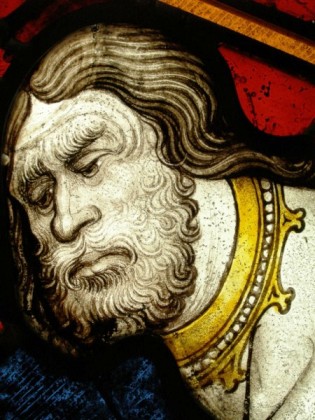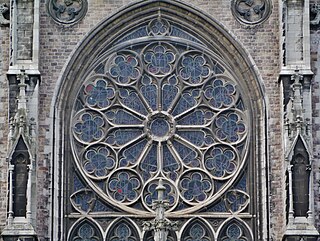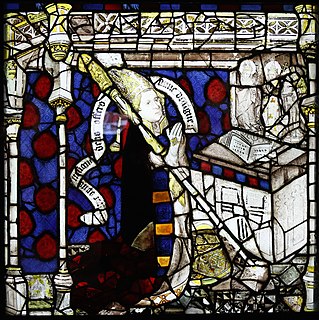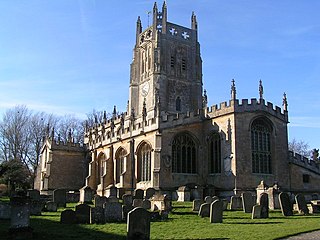
John Thornton of Coventry (fl. 1405-1433) was a master glazier and stained glass artist active in England during the 15th century. The output of his workshop includes some of the finest English medieval glass.

John Thornton of Coventry (fl. 1405-1433) was a master glazier and stained glass artist active in England during the 15th century. The output of his workshop includes some of the finest English medieval glass.
The first certain record of Thornton, apart from a possible 1371 reference in Coventry, is his 1405 contract with the Dean of York Minster to glaze the quire east window. [1] The Archbishop of York at the time was Richard le Scrope, a former Bishop of Lichfield and Coventry, and the window was funded by Walter Skirlaw, also previously Bishop of Coventry, so it seems possible both men would have recommended Thornton based on their knowledge of his work in his home town.
Thornton was made a freeman of York in 1410, but was known to be back living in the St John's Bridges area of Coventry (now known as Burges) [2] by 1413. He appears again in 1433, when he received further payment from the dean and chapter of York, and was recorded as holding property there. [1]
It has been suggested, though without any strong evidence, that Thornton was the son of a "John Coventre", a glazier in the royal glass-painting workshops at Westminster in 1351 and 1352, who later assisted in setting up windows at Windsor Castle for Edward III of England. Thornton could have worked as an assistant to his father before rising to the position of designer and draughtsman. [3]
Thornton was instrumental in disseminating the International Gothic style in the north and Midlands of England. The products of his workshop can be recognised by their favouring of white glass and yellow stain set against blue and ruby "seaweed"-patterned backgrounds, and by the very distinctive modelling of faces. [4]
Thornton's masterpiece is the Great East Window of York Minster, the largest in the building and containing about 1,680 square feet (156 m2) of glass. According to the contract, much of the work was to be executed by his own hand, though specifically only to "pourtray [...] the histories, images, and other things to be painted on the [window]"; evidently some of the glazing would be carried out by apprentices or workmen. [5] Thornton is likely to have recruited glaziers locally in York: he seems to have been an enthusiastic teacher, and his style quickly became dominant in the area. [6]
Work thought to be by Thornton can also be found in several smaller churches, as well as in St Mary's Hall in Coventry. His surviving windows for Coventry Cathedral were removed before it was destroyed in the Coventry Blitz and have been preserved. [7] He is also thought to have produced the windows from the chapel at Hampton Court, Herefordshire, which are now dispersed in various collections, and seven panels in the Church of St. Mary Magdalene, Newark-on-Trent.
The Thornton 'tradition' continued in York even after the middle of the 15th century, though many of the works produced show a coarsening or loss of quality compared with Thornton's authentic creations. [8]

The Cathedral and Metropolitical Church of Saint Peter in York, commonly known as York Minster, is the cathedral of York, England, and is one of the largest of its kind in Northern Europe. The minster is the seat of the Archbishop of York, the third-highest office of the Church of England, and is the mother church for the Diocese of York and the Province of York. It is run by a dean and chapter, under the Dean of York. The title "minster" is attributed to churches established in the Anglo-Saxon period as missionary teaching churches, and serves now as an honorific title. Services in the minster are sometimes regarded as on the High Church or Anglo-Catholic end of the Anglican continuum.

The Cathedral Church of the Holy Trinity, Saint Peter, Saint Paul and Saint Swithun, commonly known as Winchester Cathedral, is the cathedral of the city of Winchester, England, and is amongst the largest of its kind in Northern Europe. The cathedral is the seat of the Bishop of Winchester and is the mother church for the ancient Diocese of Winchester. It is run by a dean and chapter, under the Dean of Winchester.

The term stained glass refers to coloured glass as a material and to works created from it. Throughout its thousand-year history, the term has been applied almost exclusively to the windows of churches and other significant religious buildings. Although traditionally made in flat panels and used as windows, the creations of modern stained glass artists also include three-dimensional structures and sculpture. Modern vernacular usage has often extended the term "stained glass" to include domestic lead light and objets d'art created from foil glasswork exemplified in the famous lamps of Louis Comfort Tiffany.

The Cathedral Church of Saint Michael, commonly known as Coventry Cathedral, is the seat of the Bishop of Coventry and the Diocese of Coventry within the Church of England. The cathedral is located in Coventry, West Midlands, England. The current bishop is Christopher Cocksworth and the current dean is John Witcombe.

The Cathedral Church of St Peter and St Wilfrid, commonly known as Ripon Cathedral, and until 1836 known as Ripon Minster, is a cathedral in the North Yorkshire city of Ripon. Founded as a monastery by Scottish monks in the 660s, it was refounded as a Benedictine monastery by St Wilfrid in 672. The church became collegiate in the tenth century, and acted as a mother church within the large Diocese of York for the remainder of the Middle Ages. The present church is the fourth, and was built between the 13th and 16th centuries. In 1836 the church became the cathedral for the Diocese of Ripon. In 2014 the Diocese was incorporated into the new Diocese of Leeds, and the church became one of three co-equal cathedrals of the Bishop of Leeds.

Howden Minster is a large Grade I listed Church of England church in the Diocese of York. It is located in Howden, East Riding of Yorkshire, England. It is one of the largest churches in the East Riding of Yorkshire. It is dedicated to St Peter and St Paul and it is therefore properly known as 'the Minster Church of St Peter and St Paul'. Its Grade I listed status also includes the Chapter House.

A revival of the art and craft of stained-glass window manufacture took place in early 19th-century Britain, beginning with an armorial window created by Thomas Willement in 1811–12. The revival led to stained-glass windows becoming such a common and popular form of coloured pictorial representation that many thousands of people, most of whom would never commission or purchase a painting, contributed to the commission and purchase of stained-glass windows for their parish church.

Walter Skirlaw was an English bishop and diplomat. He was Bishop of Durham from 1388 to 1406. He was an important adviser to Richard II of England and Henry IV of England.
The decade of the 15th century in art involved some significant events.

English Gothic is an architectural style that flourished from the late 12th until the mid-17th century. The style was most prominently used in the construction of cathedrals and churches. Gothic architecture's defining features are pointed arches, rib vaults, buttresses, and extensive use of stained glass. Combined, these features allowed the creation of buildings of unprecedented height and grandeur, filled with light from large stained glass windows. Important examples include Westminster Abbey, Canterbury Cathedral and Salisbury Cathedral. The Gothic style endured in England much longer than in Continental Europe.
Events from the 1400s in England.
William Peckitt was an English glass-painter and stained glass maker. He was based in York throughout his working life, was one of the leading Georgian glass craftsmen in England and helped “keep the art of glass painting alive during the eighteenth century". In fact, "it was William Peckitt who did most of the stained glass and painted glass work that survives from the second half of the eighteenth century".
Nicholas Patrick Reyntiens OBE is a British stained glass artist, described as "The leading practitioner of stained glass in this country".
Thomas Glazier of Oxford was a master glazier active in England during the late 14th and early 15th century; he is one of the earliest identifiable stained glass artists, and is considered a leading proponent of the International Gothic style.

St Peter and St Paul is a church in the town of Bromley, Borough of Bromley, in south east London. Known familiarly as Bromley Parish Church, it is not far from Bromley High Street and approximately halfway between Bromley North and Bromley South railway stations. The church is part of the Diocese of Rochester within the Church of England. Largely destroyed by bombing during the Second World War, St Peter and St Paul was rebuilt in the 1950s. It has been Grade II* listed since 1955.

William Holland was a 19th-century British maker of stained glass and other decorative pieces. His work is represented in churches and stately homes across southern England, Wales, and Ireland. Holland of Warwick windows can be identified by his mark "Guil Holland Vaivic. Puix " written on a scroll in Latin in the lower right hand corner. Holland's stained glass reflects the influence of the Cambridge Camden Society and the Gothic Revival work of Thomas Willement. Willement revived in the early 19th century, the method used at York Minster to build the Great East Window in 1400 wherein coloured pieces are leaded and the lead then becomes part of the design, appearing as black lines in the window.
Arnold of Nijmegen was a 15th-century Dutch stained glass artist who worked in both modern-day Belgium and France, adopting the Renaissance style and influencing the stained glass workshops of Normandy. His best known works are a series of windows depicting historical subjects in Tournai Cathedral, Belgium. His work is known for its delicate draftsmanship, brilliance of colouring, the rich decoration of robes and detailed architectural settings. He was praised in his own time by the writers Noviomagus (1522) and Francesco Guicciardini.

The Fairford stained glass is a set of 28 pre-Reformation stained glass windows located in St Mary's Church, Fairford, Gloucestershire. The medieval stained glass panes are of national historical and architectural importance as they constitute what is "probably the most complete set of medieval stained glass in Britain" consisting of 28 windows displaying biblical scenes. They were added after the church had been rebuilt by the wealthy wool merchant John Tame (c.1430–1500). The glass was made between 1500 and 1517 under the instructions of his son, Edward Tame.

English Gothic stained glass windows were an important feature of English Gothic architecture, which appeared between the late 12th and late 16th centuries. They evolved from narrow windows filled with a mosaic of deeply-coloured pieces of glass into gigantic windows that filled entire walls, with a full range of colours and more naturalistic figures. In later windows, the figures were often coloured with silver stain, enamel paints and flashed glass. Later windows used large areas of white glass, or grisaille, to bring more light into the interiors.

Peter Gibson MBE, OBE was an English glazier and craftsman who was known for his work at York Minster in York, England. He was the founder of York Glaziers Trust in 1967, and was its superintendent until his retirement in 1995.
| Wikimedia Commons has media related to John Thornton . |